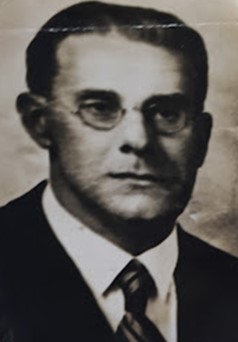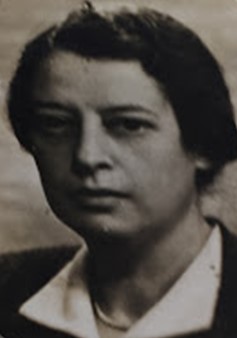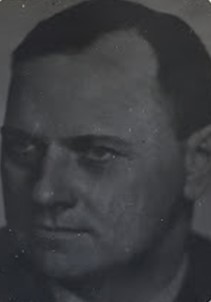Conor Brockbank, Modern History Graduate, Aberystwyth University
Part four in this blogpost series will explore the lives of refugees from National Socialism who came to work and reside in Aberystwyth due to the evacuation of artwork from the British Museum and the National Gallery, or simply as a safe haven which for some caused a halt to their careers. This blog will continue to address the questions set out in the first blog in this series, as well as considering the impact of being a refugee on their careers and livelihoods and the important roles they played in preserving artistic heritage.
To understand why the majority of German and Austrian refugees in this blog came to Mid-Wales, it is important to understand the circumstances and agreements which resulted in the moving of possessions from institutions such as the British Museum and the National Gallery to Aberystwyth. The possessions of these institutions had been moved, along with those of 74 other institutions, museums, government departments, local councils, galleries and libraries from across England and Wales, to the National Library of Wales (NLW) based in Aberystwyth from as early as September 1938. This was in-line with a wider plan originally developed in 1933, by the then First Commissioner of Works for the British Government, W.A. Ormsby-Gore MP, to ensure that no damage occurred in the case of the outbreak of a war to important assets originally from cultural and historical institutions based in London.
By 1934, the NLW had already been contacted by the British Museum, which had previously moved some of its possessions there during the First World War, to plan for them to be moved there again in the case of another war. The National Gallery also made an agreement with the NLW in September 1938 for paintings from its collections to be moved there. Importantly, when war broke out, both these institutions had also made plans with the NLW for members of their staff to also be evacuated there, including twenty members of staff from the National Gallery. It was these agreements between these organisations that resulted in many of the refugees who are the focus of this blog coming to Aberystwyth to work on categorising or photographing prints and drawings which had been moved to the NLW. They included Johannes Wilde and his wife Julia, both of whom were art historians.
Johannes and Julia were both born in Budapest in Hungary on 2June 1891 and 10 December 1895, respectively. Johannes worked at the Kunsthistorisches Museum in Vienna, Austria from 1923 until 1938, rising to the position of Keeper there, in charge of conservation. He became an Austrian citizen in 1928 and married Julia Gyárfás in 1930. Julia also became an Austrian citizen during her time there. However, after the Anschluss (annexation of Austria) in 1938, the life the Wildes had made for themselves in Vienna came under question. Johannes became increasingly concerned for Julia, who was Jewish. They decided to flee Austria in April 1939 while attending an art exhibition in Amsterdam and came to England. When they arrived, they stayed briefly with the Director of the National Gallery, Kenneth Clark. By September 1939, they were living at Toksowa Hotel in Camberwell. Johannes was working as a scientific research worker and was categorised as a C alien (exempted from restrictions) at a tribunal held in London, on 24 October 1939.
In 1940, Johannes undertook the task of cataloguing materials of the print room at the British Museum, which had been moved to the NLW. This led to the Wildes moving to Aberystwyth, where they stayed on the seafront at the Belle Vue Hotel on Marine Terrace. Julia at this time is recorded as being a housewife while they were living there, but with her background as an art historian she was no doubt of great assistance to the cataloguing Johannes was undertaking. The Wildes were, however, not in Aberystwyth long before they were both interned after Johannes was wrongfully charged with signalling enemy submarines in Aberystwyth. After their internment, they were separated, as Johannes was boarded on to the SS Ettrick on 3 July 1940 to be interned in Canada, and Julia was moved to Rushen Camp on the Isle of Man.
Johannes remained in Canada until being returned to the UK on the SS Georgia on 5 March 1941, where arrangements had been made for him to appear in front of a committee on the Isle of Man to authorise his release. He remained on the Isle of Man however until May of that year, when he was released from internment alongside Julia on 6 May 1941. They returned to Aberystwyth, as Johannes completed in 1945 the task of cataloguing evacuated materials from the print room of the British Museum, which were not returned to London until around May 1946. In 1947, Johannes became a Reader at the University of London in the History of Art. By 1950, he was the Deputy Director of the Courtauld Institute of Art in London. Johannes by 1953 had completed writing a book about the Italian drawings from the materials which had been evacuated, called Italian Drawings in the Department of Prints and Drawings in the British Museum: Michelangelo and His Studio. Johannes and Julia both passed away in 1970 in Camberwell.


Johannes Wilde (1891-1970) (right) & Julia Wilde (1895-1970) (left), 1919-1983 (right), photos within Police Memorandum Book inscribed ‘Aliens’ Photographs’, H.W.?Owen, MUS/204, Archifdy Ceredigion Archives
Much like Johannes, Walter Gernsheim was also working on material that had been moved to the NLW when he was interned. Walter was born on 30 November 1909 in Munich and was an art dealer, photographer and translator. However, with the growing prevalence of antisemitism in Nazi Germany, Walter found getting work a growing problem. This environment led him to seek refuge in London in 1934. He had begun photographing art at institutions such as the British Museum and during the war he had a War Office permit to undertake this work. As artwork from major institutions such as the National Gallery had been moved to Aberystwyth, Walter visited there to make photographs of the artwork that was set out in his government contract. While he was there with his wife Gertrude, they stayed at Lenton on Victoria Terrace. This was also where they were both interned from to the Isle of Man in June 1940. Unlike the Wildes they were both interned in the same place and even the same camp in Port Erin on the Isle of Man, which had been established as a camp for those who were married. Walter was not released from internment until November 1944. After the war, he continued alongside his brother, Helmut Gernsheim to take photographs of artworks held in various institutions as well as continuing collecting and dealing art into the early 2000s. Walter passed away in Florence, Italy in 2006.
Art historians Otto Kurz and Hilde Kurz nee Schüller, unlike Johannes and Walter, did not arrive in Aberystwyth to work on material which had been moved to the NLW until after Otto was interned. Otto and Hilde were both born in Vienna, Austria in 1908 and February 1910 respectively. They were both also art history students at the University of Vienna in the 1920s. Otto while a student there was attacked by Nazis in the library and much like Walter, he found it hard after his university studies to find work in Austria due to growing antisemitism. Through contacts he had made at the Kunsthistorisches Museum and the University of Vienna, he was able to find work at the Warburg Library in Hamburg and then relocated to London with the library in 1933. Hilde later fled to England and took up work in 1937 at the then Warburg Institute, which had changed its name after relocating. Hilde and Otto married later that year.
By 1940, the Kurzes were living on Clarendon Road in Notting Hill and while living here Otto was interned in June. Ironically, he was also listed at this address on the Gestapo’s Invasion List, which was created in the case of a German invasion. Otto spent a few months in internment until he was released on 24 September 1940. After his internment, Otto and Hilde worked on material, potentially from the Warburg Institute, which had also been moved to the NLW. Otto became the Assistant Librarian of the Warburg in 1944 and later the Librarian in 1949, a role he remained in until 1965. He also held professorships in Classical Traditions and Fine Art at London University and at Oxford. During most of Otto’s career, Hilde worked privately on his many research endeavours. Otto and Hilde passed away in London in September 1975 and March 1981, respectively.
Other refugees arrived in Aberystwyth simply as their place of safe haven, with no work or form of education there for them to take up upon their arrival, such as the agricultural expert, Franz Joseph Stanek. Franz was born on 11 November 1895 in Vienna, Austria to Anton and Maria Stanek. Before leaving Austria, Franz was an expert in agriculture but by September 1939, he had arrived in Aberystwyth and was unemployed. During his time in Aberystwyth, he lived at 6 Vulcan Street and was briefly detained as an “alien suspect” from this address and was imprisoned in HMP Swansea. This imprisonment, however, only lasted a few days before he was released under the instructions of the Home Secretary on 9 September 1939.
There is no record in-and-around the mid-to-late 1930s to indicate for how long Franz had been living in Vulcan Street in Aberystwyth before 1939, but all records do indicate that he struggled to find employment in his field while living there. His remaining time in Aberystwyth after his release from HMP Swansea was very brief, as after his internment tribunal on 23 October 1939 and categorisation as a ‘B’ alien, he left Aberystwyth nearly immediately, the next day. By April 1940, Franz had decided to go to Brazil, potentially in the pursuit of work there as he clearly continued to find it hard to gain employment in the UK. He was granted permission to move there by the Home Office on 9 April 1940. Franz then boarded alone on 6 May 1940 on to the Highland Brigade ship in London, which was travelling to Rio de Janeiro. According to the passenger list at this time, Franz was noted as being stateless. Clearly, moving to Brazil was an attempt at a fresh start and a new life there. What his life entailed after boarding this ship is unknown.

What united the majority of those explored in this blog was the necessity of the NLW and being close to evacuated books, prints and paintings, so that they could undertake their work of cataloguing and photographing. However, the lives of Johannes, Julia, Walter, Gertrude, Otto, Hilde and Franz, all further indicate the variety of the lived experiences of refugees from National Socialism. Many had fled from persecution and the barriers which had been created within their careers and fields, due to the rise of antisemitism, and many found work and made lives for themselves in Britain. Others struggled with the transition – finding work was hard, with their careers being halted and further immigration being pursued with a desire to change this.
None of these refugees, unlike the University College London students and staff, even share the exact same fundamental reasons for ending up in Aberystwyth. Each came for different reasons: some on work visits that were quickly shortened by internment, for others it became their new home while they worked there and for Franz, with no work on offer providing the motivation behind such a decision, Aberystwyth was simply his safe haven. Furthermore, some were not interned, and others were. Even these experiences differed, some were distanced from their married partners and others were interned together in the same camp. Exploring the lives of individual refugees highlights their differences and uniqueness from each other, much like the individual lives of those who entered domestic service in Aberystwyth and the surrounding areas. Their lives will be explored in the final two blogs in this series.
NB. This blog was written in conjunction with the Aberystwyth at War project. The blog can also be found on their project website.
Sources:
AJR Journal. The Association of Jewish Refugees, October 1975 & December 2013.
Berkowitz, M. ‘Lost in the Transnational: Photographic Initiatives of Walter and Helmut Gernsheim in Britain.’ In Geller, J.H., and Morris, J., eds. Three-Way Street. Jews, Germans, and the Transnational. Michigan, 2016. Pp. 144-168. Accessed via https://bit.ly/3JrOxFh, accessed 17 March 2023.
Camberwell, London, 1970, England & Wales Deaths 1837-2007, FindmyPast.
Camberwell, London, 1970, England & Wales Government Probate Death Index 1858-2019, FindmyPast.
Ciulisová, I. ‘Dvorcik’s Pupil Johannes Wilde (1891-1970).’ Umeni Art, 60 (2012): 101-108.
Davies, W. Ll. ‘War-Time Evacuation to the National Library of Wales.’ Transactions of the Honourable Society of Cymmdorion, Session 1945 (1946): 171-178.
Franz Joseph Stanek Internment Exemption Record, 1939, The National Archives, HO 396/240.
Franz Stanek Immigration Card, 9 April 1940, Rio de Janeiro, Brazil, 1940, Immigration Cards, 1900-1965, MyHeritage.
Franz Stanek Interment, Reception and Internment of Aliens: List of Internees, 1939, The National Archives, PCOM 9/661.
Franz Stanek, Rio de Janeiro, Brazil, 6 May 1940, Passengers List Leaving UK 1890-1960, FindmyPast.
Gertrude Gernsheim Internment Record, 1940, The National Archives, HO 396/254.
Gertrude Gernsheim Internment Release Record, 1944, The National Archives, HO 396/21.
Hammel, A., and Grenville, A., eds. Refugee Archives. Theory and Practice. Amsterdam, 2007.
Hilde Kurz Internment Exemption Record, 1939, The National Archives, HO 396/50.
Illustrated London News, 18 March 1950.
Johannes Wilde Internment Release Record, 1941, The National Archives, HO 396/133.
Johannes Wilde Internment Release to U.K. Record, 1941, The National Archives, HO 396/127.
Julia Wilde Internment Record, 1940, The National Archives, HO 396/282.
Julia Wilde Internment Release Record, 1941, The National Archives, HO 396/201.
Kocham, M. Britain’s Internees in the Second World War. London, 1983.
Kurz, Hilde, Dictionary of Art Historians, https://bit.ly/3ZGE2os, accessed 11 March 2023.
Kurz, Otto, Dictionary of Art Historians, https://bit.ly/3JxnARL, accessed 11 March 2023.
Kurz, Otto, Gestapo Invasion Arrest List, 1940, Hoover Library.
Malet, M., and Behr, S., eds. Arts in Exile in Britain 1933-1945. Politics and Cultural Identity. Leiden, 2015.
Otto Kurz Internment Record, 1940, The National Archives, HO 396/264.
Otto Kurz Internment Release Record, 1940, The National Archives, HO 396/183.
Police Memorandum Book inscribed ‘Aliens’ Photographs’, H.W.?Owen, Archifdy Ceredigion Archives, MUS/204.
Ralph Court, Queensway, London, 1975, England & Wales Government Probate Death Index 1858-2019, FindmyPast.
Rose, L. Psychology, Art, and Antifascism. Ernst Kris, E.H. Gombrich, and the Politics of Caricature. New Haven, 2016.
Shenton, C. National Treasures. Saving the Nation’s Art in World War II. London, 2021.
Snowman, D. The Hitler Emigrés. The Cultural Impact on Britain of Refugees from Nazism. New York, 2010.
St Pancras, London, 1975, England & Wales Deaths 1837-2007, FindmyPast.
Toksowa Hotel, Dulwich Common Street, Camberwell, Southwark, 1939 Register.
Vulcan Street, Aberystwyth, 1939 Register.
Walter and Gertrude Gernsheim, 1943, Nominal Roll, Married Camp, Isle of Man, The National Archives, HO 215/502.
Walter Gernsheim Internment Record, 1940, The National Archives, HO 396/254.
Walter Gernsheim Internment Release Record, 1944, The National Archives, HO 396/203.
Walter Gernsheim, Deutsche Digitale Bibliothek Kultur und Wissen Online, https://bit.ly/3JzEsaG, accessed 11 March 2023.
Westminster, London, 1981, England & Wales Deaths 1837-2007, FindmyPast.
Wilde, J. Italian Drawings in the Department of Prints and Drawings in the British Museum: Michaelangelo and His Studio. London, 1953.
Wilde, Johannes, Dictionary of Art Historians, https://bit.ly/3LhTMdg, accessed 11 March 2023.
Photos used with the permission of Archifdy Ceredigion Archives, Aberystwyth.